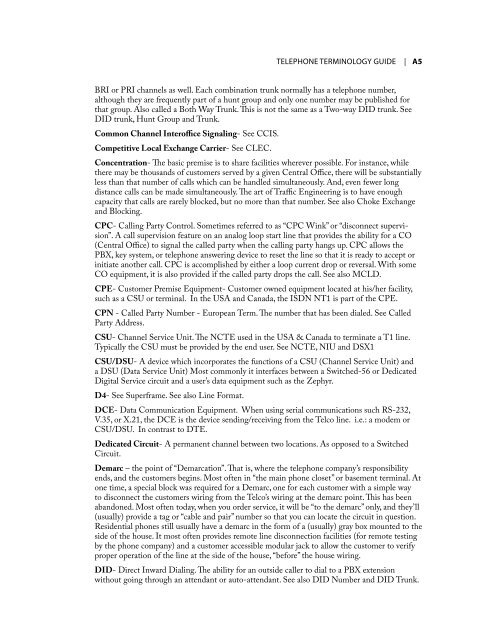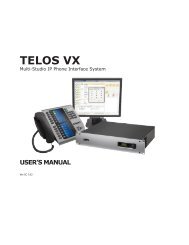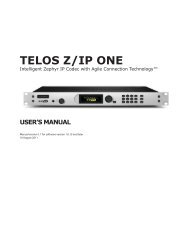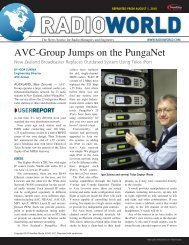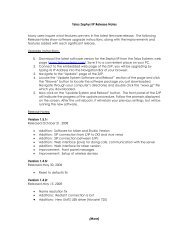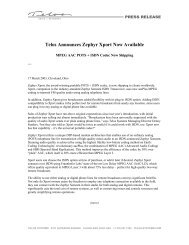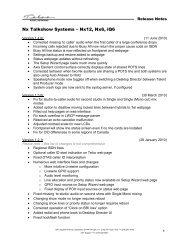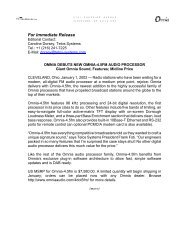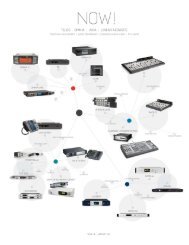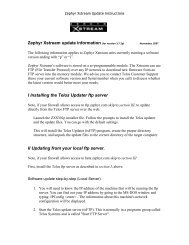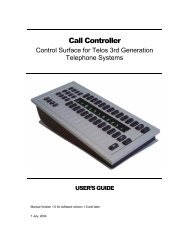Hx1-Hx2 Manual-1.4.1 - Telos
Hx1-Hx2 Manual-1.4.1 - Telos
Hx1-Hx2 Manual-1.4.1 - Telos
Create successful ePaper yourself
Turn your PDF publications into a flip-book with our unique Google optimized e-Paper software.
TelepHone TerMInoloGy GuIDe | A5<br />
BRI or PRI channels as well. Each combination trunk normally has a telephone number,<br />
although they are frequently part of a hunt group and only one number may be published for<br />
that group. Also called a Both Way Trunk. This is not the same as a Two-way DID trunk. See<br />
DID trunk, Hunt Group and Trunk.<br />
Common Channel Interoffice Signaling- See CCIS.<br />
Competitive Local Exchange Carrier- See CLEC.<br />
Concentration- The basic premise is to share facilities wherever possible. For instance, while<br />
there may be thousands of customers served by a given Central Office, there will be substantially<br />
less than that number of calls which can be handled simultaneously. And, even fewer long<br />
distance calls can be made simultaneously. The art of Traffic Engineering is to have enough<br />
capacity that calls are rarely blocked, but no more than that number. See also Choke Exchange<br />
and Blocking.<br />
CPC- Calling Party Control. Sometimes referred to as “CPC Wink” or “disconnect supervision”.<br />
A call supervision feature on an analog loop start line that provides the ability for a CO<br />
(Central Office) to signal the called party when the calling party hangs up. CPC allows the<br />
PBX, key system, or telephone answering device to reset the line so that it is ready to accept or<br />
initiate another call. CPC is accomplished by either a loop current drop or reversal. With some<br />
CO equipment, it is also provided if the called party drops the call. See also MCLD.<br />
CPE- Customer Premise Equipment- Customer owned equipment located at his/her facility,<br />
such as a CSU or terminal. In the USA and Canada, the ISDN NT1 is part of the CPE.<br />
CPN - Called Party Number - European Term. The number that has been dialed. See Called<br />
Party Address.<br />
CSU- Channel Service Unit. The NCTE used in the USA & Canada to terminate a T1 line.<br />
Typically the CSU must be provided by the end user. See NCTE, NIU and DSX1<br />
CSU/DSU- A device which incorporates the functions of a CSU (Channel Service Unit) and<br />
a DSU (Data Service Unit) Most commonly it interfaces between a Switched-56 or Dedicated<br />
Digital Service circuit and a user’s data equipment such as the Zephyr.<br />
D4- See Superframe. See also Line Format.<br />
DCE- Data Communication Equipment. When using serial communications such RS-232,<br />
V.35, or X.21, the DCE is the device sending/receiving from the Telco line. i.e.: a modem or<br />
CSU/DSU. In contrast to DTE.<br />
Dedicated Circuit- A permanent channel between two locations. As opposed to a Switched<br />
Circuit.<br />
Demarc – the point of “Demarcation”. That is, where the telephone company’s responsibility<br />
ends, and the customers begins. Most often in “the main phone closet” or basement terminal. At<br />
one time, a special block was required for a Demarc, one for each customer with a simple way<br />
to disconnect the customers wiring from the Telco’s wiring at the demarc point. This has been<br />
abandoned. Most often today, when you order service, it will be “to the demarc” only, and they’ll<br />
(usually) provide a tag or “cable and pair” number so that you can locate the circuit in question.<br />
Residential phones still usually have a demarc in the form of a (usually) gray box mounted to the<br />
side of the house. It most often provides remote line disconnection facilities (for remote testing<br />
by the phone company) and a customer accessible modular jack to allow the customer to verify<br />
proper operation of the line at the side of the house, “before” the house wiring.<br />
DID- Direct Inward Dialing. The ability for an outside caller to dial to a PBX extension<br />
without going through an attendant or auto-attendant. See also DID Number and DID Trunk.


